While we see another year off, ANN would like to use this space
to pay tribute to those in aerospace and aviation who will not be
among us as we welcome in the New Year.

Some left us far too early; others lived long, healthy lives.
But whatever the individual circumstances, we honor these folks for
their courage, contributions, and prescience in the field of
aerospace that bonds us all...
4 January: Brigadier General (Retired)
Kenneth R. Milam, USAF -- Over a career spanning 25
years, Milam served three years as a fighter pilot in Korea and
Japan. He then left active service for eight months in 1956, but
returned to the Air Force in 1957, and spent one year ferrying
fighter aircraft to North Atlantic Treaty Organization countries.
Following that, he flew F-100s at Myrtle Beach Air Force Base, SC,
before his reassignment to Strategic Air Command. In September 1966
Milam returned to fighters as an F-4 aircraft commander at George
Air Force Base, CA. In March 1967 he was assigned duty in Southeast
Asia where he flew more than 100 combat missions over North Vietnam
in the F-4. He also flew combat missions in the T-28, 0-1, and A-1
aircraft, before returning to the States. In November 1967 and took
leave from the Air Force after his selection by 20th Century Fox as
a stunt pilot for to combat scenes in the motion picture "Tora!
Tora! Tora!."
 8 January: William "Bill"
Kershner -- If you learned to fly in the past 50
years, chances are you studied from a book authored by Kershner,
who flew his first solo in an Aeronca Defender in 1945. He wrote
and illustrated five highly regarded flight manuals, including his
Student Pilot's Flight manual... which alone has sold over one
million copies. Kershner was also a firm believer in spin recovery
training, an area private pilot training has shied away from in
recent years. He logged more than 8,000 spins.
8 January: William "Bill"
Kershner -- If you learned to fly in the past 50
years, chances are you studied from a book authored by Kershner,
who flew his first solo in an Aeronca Defender in 1945. He wrote
and illustrated five highly regarded flight manuals, including his
Student Pilot's Flight manual... which alone has sold over one
million copies. Kershner was also a firm believer in spin recovery
training, an area private pilot training has shied away from in
recent years. He logged more than 8,000 spins.
12 January: Hayden "Buck"
Gregory -- People like Hayden "Buck" Gregory were the
reason those who fought in World War II -- or served their country
in other capacities -- earned the title "The Greatest Generation."
Gregory was a Naval cadet when the Japanese attacked Pearl Harbor,
and later flew Kingfisher observation planes on anti-submarine
patrols near Cuba. He was assigned later to Fighter Squadron 82,
flying off the aircraft carrier USS Bennington. Gregory had five
confirmed kills in WWII, including three kamikaze planes in one
day. That earned him "Ace" status, as well as the Silver Star and
the Distinguished Flying Cross. It was a far cry from his earlier
days, growing up on a West Texas ranch.
 16 February: Derrick Vogt --
The ANN staff still reels from the loss of one of our own.
Derrick was a retired Cessna worker who selflessly contributed to
our annual coverage of Oshkosh for the past several years. He was a
unique fellow... a guy who took great pride in being a member of
the aviation world, a quiet man most knowledgeable about the
real-world of general aviation and one who had become a great fan
of ANN... so great a fan, he decided that he had to make part of it
his own... and he did. Derrick would show up for each Oshkosh,
prepared to do whatever he could to make a contribution to the
annual insanity that ANN undergoes at Wittman Field each summer. He
was a tireless friend, a willing gopher, a ready photographer, a
timely Chauffeur/Golf-Cart Pilot... you name it. When you needed a
spare hand, it usually belonged to Derrick -- and that hand always
had a grin attached. We miss you, our friend.
16 February: Derrick Vogt --
The ANN staff still reels from the loss of one of our own.
Derrick was a retired Cessna worker who selflessly contributed to
our annual coverage of Oshkosh for the past several years. He was a
unique fellow... a guy who took great pride in being a member of
the aviation world, a quiet man most knowledgeable about the
real-world of general aviation and one who had become a great fan
of ANN... so great a fan, he decided that he had to make part of it
his own... and he did. Derrick would show up for each Oshkosh,
prepared to do whatever he could to make a contribution to the
annual insanity that ANN undergoes at Wittman Field each summer. He
was a tireless friend, a willing gopher, a ready photographer, a
timely Chauffeur/Golf-Cart Pilot... you name it. When you needed a
spare hand, it usually belonged to Derrick -- and that hand always
had a grin attached. We miss you, our friend.
23 March: Doolittle Raider Lt. Colonel
Chase J. Nielsen -- Born January 14, 1917 in Hyrum, UT
Colonel Nielsen attended Utah State University and graduated in
1939 with a bachelor of science degree in civil engineering. In
August 1939, he enlisted in the US Army Air Corps as a flying
cadet. He was commissioned as a second lieutenant in June 1941.
Nielsen, a lieutenant at the time, was the navigator of "Crew #6",
one of 16 B-25 Mitchell bombers and 80 Airmen that launched from
the deck of the USS Hornet on April 18, 1942. Most of the aircraft
were able to reach land, but two, including Colonel Nielsen's, were
forced to ditch off the coast of China. Two men were killed in the
ditching. Nielsen spent the next 40 months as a prisoner of war,
most of the time in solitary confinement, before being rescued at
the end of the war by an Office of Strategic Services para-rescue
team and brought back to the US. He returned to Shanghai, China, in
January 1946 to testify in the International War Crimes Trials
against his former captors.

7 April: Homebuilt Aircraft Designer Leeon
Davis -- One of the most uniquely prolific
homebuilders in aviation, Davis began his aviation career in the US
Air Force, before returning to civilian life as a metal worker at
Aero Commander's prototype facility in Norman, OK. From the
beginning, Davis had a fondness for simple, efficient, rugged
V-tail designs... that made up for in flying qualities what they
may have arguably lacked in visual grace. Davis built his first
aircraft, the DA-1A, in 1958. Next came the DA-2A, introduced in
the mid-1960s. Powered by either an Continental A-95, C-80/90 or
Lycoming O-200, the DA-2A was composed almost entirely of flat
aluminum panels; at first glance, seemingly the only curves to be
found were in the upper surface of the wing, and the three wheels
comprising the tricycle landing gear. The simple construction and
somewhat awkward lines belied a truly capable airplane, however,
capable of carrying two adults and a child at speeds over 100 mph,
all while burning about five gallons per hour. Davis toyed with a
number of designs over the years, and in 1990 unveiled the sleek
DA-9 Super Pocket Rocket, powered by a 40-hp two-cylinder motor.
Flown on a series of record flights, the DA-9 could fly at speeds
up to 260 mph.
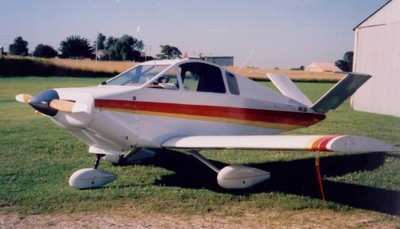
14 April: Aviation Author Robert N.
Buck -- The former Trans World Airlines pilot flying
records as a teenager in the 1930s and flew severe-weather research
missions during World War II, before starting upon a renowned
career as an aviation author. Buck began his stellar aviation
career as a 15-year-old glider pilot in New Jersey in 1929. The
longtime AOPA Air Safety Foundation Board of Visitors member flew
until he was 88. When he was 15, he and a fellow high school
student built and flew their own glider, which was towed by a Model
A Ford at a local grass airstrip. On September 29, 1930 --
reportedly equipped with six chocolate bars and a canteen -- Buck
climbed into a Pitcairn Mailwing at Newark Airport and took off for
Los Angeles making an attempt at the junior transcontinental
airspeed record, which he did by an hour and eight minutes. He told
the story of his early days as a pilot in his first book, "Burning
Up the Sky," published in 1931 by G.P. Putnam's Sons -- however,
Buck is best known for his 1970 book "Weather Flying," considered a
must-read for pilots. He also wrote "Flying Know-How," "The Art of
Flying," "The Pilot's Burden: Flying Safely and the Roots of Pilot
Error" and "North Star Over My Shoulder," his 2002 memoir.
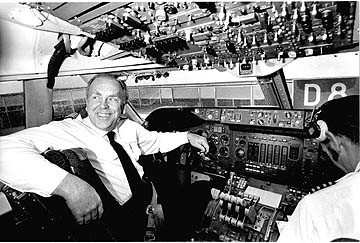
03 May: Walter Marty "Wally" Schirra,
Jr. -- Originally recruited as one of the original
Mercury 7 astronauts by NASA in 1959, Schirra would go on to become
the only astronaut to fly in the agency's first three manned space
programs -- Mercury, Gemini, and Apollo. Each of his missions built
on those before, and laid the foundation for more advanced missions
to follow. Schirra flew on the fifth Mercury flight in 1962,
orbiting the Earth six times in his Sigma 7 capsule -- the longest
US manned space mission up to that point. He commanded Gemini 6A in
1965, a flight with Tom Stafford that had the historic distinction
of being the first rendezvous of two manned, maneuverable
spacecraft. Three years later, Schirra commanded Apollo 7 -- the
first manned Apollo flight, which followed the January 1967
launchpad fire that claimed the lives of Apollo 1 astronauts Edward
White, Roger Chaffee, and Virgil Grissom (who was also a Mercury
and Gemini astronaut.) During the 11-day flight of Apollo 7 in
1968, Schirra and fellow crewmembers Walt Cunningham and Donn
Eisele tested the redesigned Apollo systems, and proved the
spacecraft was ready to take astronauts to the moon.
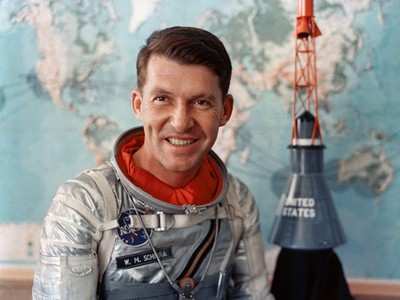
09 May: Jim Larkin -- Larkin
was actively involved in Idaho aviation for more than 65 years. His
flying career took off in 1937 when he completed his military
training at the top of his class. He completed Civilian Pilot
Training then moved on to United States Army Air Force Instructor
School at Randolph Field, TX. He was assigned to the Rankin
Aeronautical Academy, flying the Stearman PT-17, then moved on to
Air Force Air Transport Command, 6th Ferry Group, stationed in Long
Beach, CA where he ferried all manner of aircraft all over the
world. After high-altitude training in the C-46 Curtiss Commando,
he was assigned to China-Burma-India Theater (CBI) at Mohanbari,
India, flying "Hump Runs" to Western China and Burma. Larkin's
post-war life included the purchase of a 1932 UMF Sport Waco with
his brothers that reportedly belonged to movie star and pilot Brian
Aherne (1902-1986) at one time. Ever the innovator, when it was
realized there was no place to keep the plane, he and his brothers
simply converted the family farmland into what is now the Donnelly
airport. Later in his life, Larkin joined the newly-formed Boise
Interagency Fire Center from which he retired in l978 as Director.
In 1960, he made the first "Super Tanker" mission flying on a
wildfire near Trinity Mountain, east of Boise.
17 May: Petro Balabuyev --
Balabuyev headed the Kiev-based Antonov aviation design bureau for
almost 20 years. He was the top designer for several different
aircraft, including the An-124-100, and the largest aircraft in
world, the An-225 Mriya. The designer also participated in
designing such aircraft as the AN-22 Antei, AN-72, AN-74, AN-32,
AN-28, AN-124 Ruslan in addition to the Mriya, which is Ukrainian
for 'dream'. His most recent developments included the AN-140, a
passenger aircraft, and the multi-purpose AN-3. Balabuyev was also
the current Chairman of the Board of Directors of the International
Consortium Medium Transport Plane, according to the Ukrainian
National Radio.
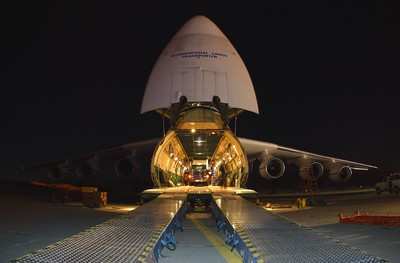
23 May: Former Boeing Executive Jim
Blue -- Blue's "lean manufacturing" initiatives
transformed Boeing's production methods over the course of two
decades. He was recognized for driving quality improvements and
cost-saving efficiencies at the company's highest levels, including
sending top management to Japan to study production philosophies
and Toyota assembly lines. He was also instrumental in bringing the
Concorde to Seattle's Museum of Flight. Born in 1929 in Wichita,
KS, Blue's father had worked at Boeing there, in a warehouse job
and managing airplane parts. During summers in high school, Blue
worked in the Boeing warehouse, unloading boxcars. From there he
ascended the ranks at the Seattle planemaker, working in management
on the 747 jumbo-jet program, and later managing the organization
providing after-sales support to airlines. In the mid-'80s, when
airlines raised issues of airplane-quality to Boeing's president,
Blue was appointed head of quality management.
26 May: Rocket Pioneer Homer
Stewart -- An aerospace engineer who helped develop
the first successful US satellite, Stewart was born in Lapeer, MI,
the son of a physicist. After graduating from the University of
Minnesota, the Dubuque, IA native came to the California Institute
of Technology for graduate study in 1936, and became interested in
the early pioneering rocket research that was being carried out at
the time by a small group of Caltech engineers and scientists --
chief among them Theodore von Kármán. He was chief of
JPL's liquid propulsion systems division when JPL and the Army
Ballistic Missile Agency (now the Marshall Space Flight Center)
developed and launched Explorer I, the first artificial satellite
launched by the United States. In the late 1950's, Dr. Stewart
worked as the director of planning and evaluation for the rookie
agency, National Aeronautics and Space Administration, and in 1959
joined German rocket pioneer Wernher von Braun in testifying before
a Senate panel, asserted Russian space technology was a good 12-20
months ahead of the US -- and that the USSR's missile guidance
systems were far along enough to strike an American city from 5,000
miles away.
27 May: Paul 'Ed' Yost -- The
founder of the Balloon Federation of America, Yost is often
credited with making the first free flight in a modern hot-air
balloon in October 1955. That aircraft sported a plastic envelope
and was fueled by kerosene -- design attributes Yost later revised
into today's propane-fueled, nylon-envelope hot air balloons. Yost
further refined the modern-day balloon with other features which he
patented. These include nonporous synthetic fabrics, maneuvering
vents, and deflation systems for landing. Yost also designed the
distinctive "teardrop" shape of the hot air balloon envelope
itself. On April 13, 1963, Yost -- along with photographer Don
Piccard -- launched the 60,000 cubic foot hot air balloon "Channel
Champ" from Rye, England, and effectively introduced the hot air
balloon to the world. In 1976, Yost made the first attempt to cross
the Atlantic in a hot air balloon in the "Silver Fox." That flight
ended some 2,700 miles from the starting point in Milbridge, ME, in
the sea approximately 700 miles west of Portugal.
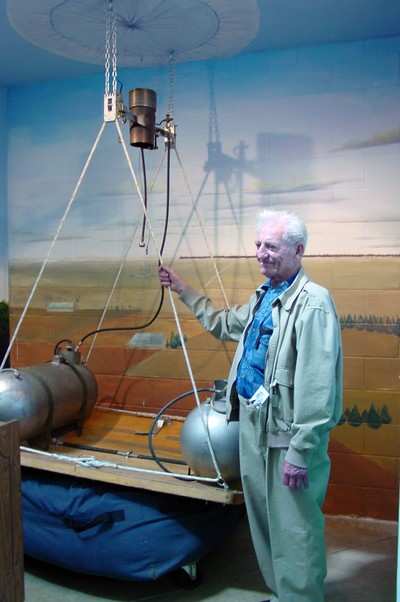
30 May: Rural Aviation Pioneer Ossie
James -- Hailed as an aviation and agriculture legend
in New Zealand, James was considered a founding father of New
Zealand rural aviation, leading to the development of a thriving
aviation hub around Hamilton airport. An apprentice motor mechanic
from 1935 to 1939, James served as a fighter plane technician
during World War II. He earned his pilot's license and bought his
first airplane, a Tiger Moth, in 1947. Two years later he founded
James Aviation. Starting with only the single Tiger Moth biplane,
he expanded James Aviation until the company was flying 85 planes
across the country. He also bought Australian businesses, expanding
operations across the Tasman. He converted a DC-3 so it could be
used for top-dressing, and introduced the first helicopter into
agricultural aviation. Most recently James was co-founder of
Fieldays, the largest agricultural trade show in the Southern
Hemisphere.
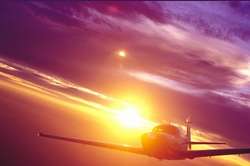 11 June: Cole Kugel, Oldest Living
Licensed Pilot In US -- Kugel was born March 14, 1902,
near Lamont in the Oklahoma Territory. He began flying along with
his brother Paul, who died in 1991, after catching the flying bug
watching barnstormers doing air acrobatics in 1929, and bought his
first plane in 1929 for $3,700. After a brief, involuntary
flying hiatus during the Depression, he and his wife, Mildred,
moved to Longmont in 1943 and he was back in the air. Kugel passed
away at the age of 105. Two days before turning 103, the FAA
awarded Kugel the Golden Wings Award for aviation pioneers. Just
days after his 99th birthday in 2001, Kugel was entered into
Guinness Book of World Records as the oldest qualified pilot in the
world.
11 June: Cole Kugel, Oldest Living
Licensed Pilot In US -- Kugel was born March 14, 1902,
near Lamont in the Oklahoma Territory. He began flying along with
his brother Paul, who died in 1991, after catching the flying bug
watching barnstormers doing air acrobatics in 1929, and bought his
first plane in 1929 for $3,700. After a brief, involuntary
flying hiatus during the Depression, he and his wife, Mildred,
moved to Longmont in 1943 and he was back in the air. Kugel passed
away at the age of 105. Two days before turning 103, the FAA
awarded Kugel the Golden Wings Award for aviation pioneers. Just
days after his 99th birthday in 2001, Kugel was entered into
Guinness Book of World Records as the oldest qualified pilot in the
world.
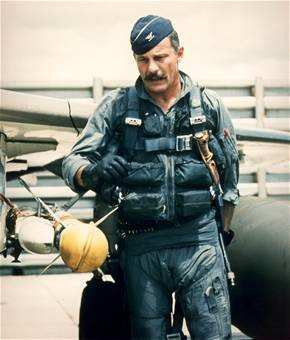 14 June: Triple Ace Brigadier General
Robin Olds, USAF, Retired -- A veteran of WWII and
Vietnam, Olds earned more combat medals than you could carry. He
became a "triple ace," even though it took 23 years. His exploits
as the creator and Mission Commander of "Operation Bolo," the most
successful aerial battle of the Vietnam conflict, were documented
by the History Channel Dogfights Special series, "Air Ambush." Olds
shot down a total of 17 enemy aircraft, and was credited with 24.5
victories, 12 aircraft shot down, and 11½ aircraft destroyed
on the ground.
14 June: Triple Ace Brigadier General
Robin Olds, USAF, Retired -- A veteran of WWII and
Vietnam, Olds earned more combat medals than you could carry. He
became a "triple ace," even though it took 23 years. His exploits
as the creator and Mission Commander of "Operation Bolo," the most
successful aerial battle of the Vietnam conflict, were documented
by the History Channel Dogfights Special series, "Air Ambush." Olds
shot down a total of 17 enemy aircraft, and was credited with 24.5
victories, 12 aircraft shot down, and 11½ aircraft destroyed
on the ground.
17 June: Gyroplane Pioneer Chuck
Vanek -- Though he had some aeronautical
education in college, Vanek initially chose a career as a police
officer in Portland, OR. When he saw pictures of Dr. Igor Bensen's
first Bensen Gyrocopter, with its frame built of heavy water pipe,
he was inspired to explore his own designs. By 1957, Chuck was
flying the first Vancraft gyroplane over Scappoose, OR. By the
following year, some friends were joining him. While Bensen quickly
abandoned crude water pipe airframes in favor of bolted aluminum
tubing, Vancraft machines were made of welded mild steel tube.
Vanek was the father of Jim Vanek, president of Sport Copter.
28 June: Former Alaska Air CEO Bruce R.
Kennedy -- Kennedy led Alaska Airlines' expansion as
an international carrier. A company director since 1972, Kennedy
served in one or more capacities as Alaska Airlines' chairman, CEO,
and president between 1978 and 1991. He also held the same
positions with Alaska Air Group from its inception in 1985 to 1991.
Kennedy oversaw Alaska Air Group's acquisition of Horizon Air and
Jet America, fueling the company's growth from an airline serving
Seattle and 10 cities in Alaska to a combined operation today with
92 destinations in the US, Canada, and Mexico. During his tenure,
revenues increased tenfold to surpass one billion dollars, and both
airlines (Alaska Airlines and Horizon Air) became widely recognized
for excellent customer service and for an unexcelled record of
consistent profitability. He continued to serve on the board of
Alaska Air Group after his early retirement from the company in
1991.
 Aero-News: Quote of the Day (10.16.25)
Aero-News: Quote of the Day (10.16.25) Airborne 10.15.25: Phantom 3500 Confounds, Citation CJ3 Gen2 TC, True Blue Power
Airborne 10.15.25: Phantom 3500 Confounds, Citation CJ3 Gen2 TC, True Blue Power ANN's Daily Aero-Term (10.16.25): Enhanced Flight Vision System (EFVS)
ANN's Daily Aero-Term (10.16.25): Enhanced Flight Vision System (EFVS) True Blue Power and Mid-Continent Instruments and Avionics Power NBAA25 Coverage
True Blue Power and Mid-Continent Instruments and Avionics Power NBAA25 Coverage NTSB Final Report: Bellanca 17-30A
NTSB Final Report: Bellanca 17-30A













